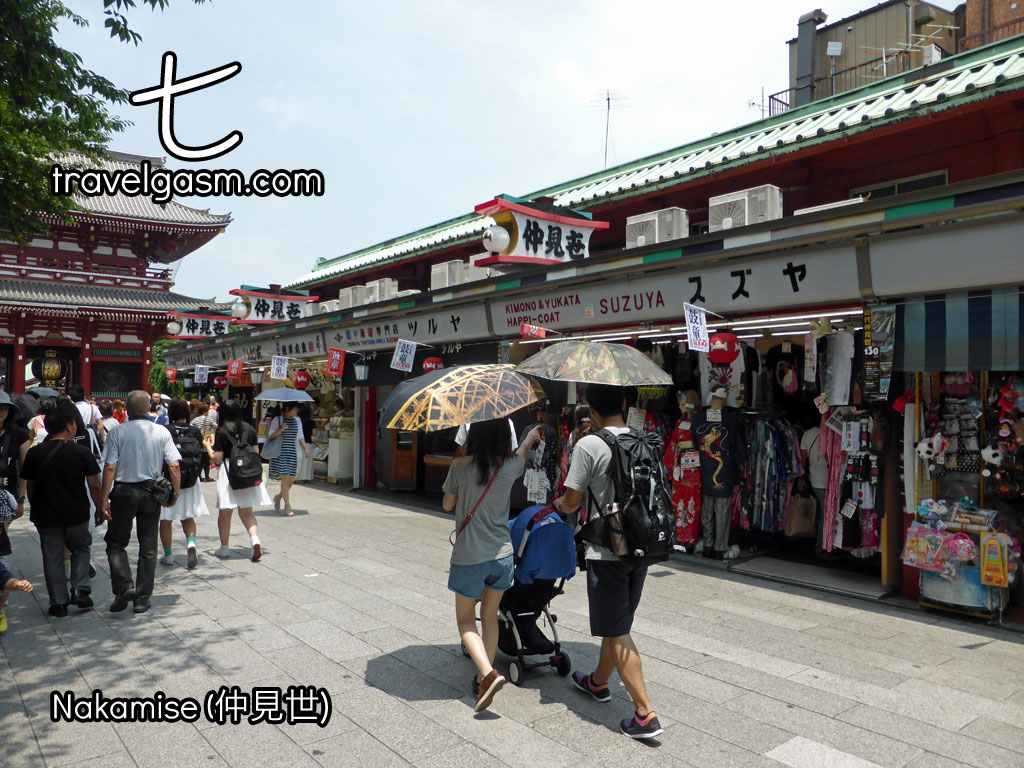Cities > Tokyo > 7 Things Tourists Do in Tokyo That You Should Do Also...
7) Admire Asakusa
Asakusa: Kaminarimon, Hozomon, Senso-ji, Nakamise & More

Asakusa (浅草) is famous for hosting Senso-ji (浅草寺) — also referred to as Asakusa Kannon — one of the largest and most famous Buddhist temples in Japan. First built in 628, and rebuilt several times after a number of fires, earthquakes, and wars, Senso-ji is an important destination for Japanese Buddhists and a well-worn photo op for tourists.
Tourists tend to swarm particularly around the attractive Kaminarimon (雷門) and Hozomon (宝蔵門) gates en route to the temple. By mid-morning, the entire complex is so crowded with pushy and often disrespectful visitors that Senso-ji can feel less like a religious experience and more like an amusement park. However, the temple opens at 6 AM so travelgasm.com would recommend making an effort to transcend the tourist crowds by arriving as early as possible.
In between the two gates — Kaminarimon and Hozomon — is the famous people-only Nakamise Shopping Street (仲見世商店街). Apart from the often thick crowds, Nakamise is a pleasant walk, but it would be easy to dismiss it as a gauntlet of stalls selling tourist tat — and it is for the most part — but it also is one of the oldest shopping streets in Japan. In fact, Nakamise can trace its origins all the way back to the Edo era before modern Tokyo entirely. Nakamise has been selling souvenirs to those showing up to see Senso-ji for a very long time.
In addition to cheap souvenirs, Nakamise provides an easy opportunity to buy Japanese street food. Famous snacks available at Nakamise include tempura (天ぷら), breaded and deep fried shrimp and vegetables; dango (団子), sticky balls made from rice flour, coated in an assortment of sweet pastes, and served on a bamboo skewer; kaminari-okoshi (雷おこし), the Edo-era precursor of Rice Krispy treats (but instead of using marshmallow paste to hold popped rice together they use sugar syrup); and senbei (煎餅), roasted rice crackers often served with seaweed. Tempura and dango are best eaten on the spot, but kaminari-okoshi and senbei also are sold attractively packaged and are popular gifts to take back home.
Another pleasant, small-scale street in the neighborhood is Shin Nakamise (新仲見世商店街) — a short street with a covered archway — much like a passage in Paris — that is reserved for people only and lined with restaurants and shops. Shin means "new" in Japanese, and Shin Nakamise is parallel to the older Nakamise, but it is attached to Exit 1 of the Asakusa Metro Station. Because Shin Nakamise is covered, it can be especially useful when it is raining.
Be sure also to see the nice people-priority street in the neighborhood, Dempoin Street (伝法院通り), that runs perpendicular to Nakamise. Dempoin is partially reconstructed, but it feels like an old Edo-era street — or at least an amusement park version — complete with shops that have wooden facades and Japanese screen doors. It's a fun stroll and a comfortable place to go shopping.
To eat in Asakusa, there literally are hundreds of restaurants, but three that we enjoyed at one time or another include Yadoroku (宿六), which claims to be the oldest onigiri (お握り) — rice ball — shop in Tokyo; Owariya (尾張屋) for buckwheat soba noodles (そば); and Suzukien (壽々喜園), famous for its seven "intensities" of green tea gelato.
We've mapped out the quickest route from the metro to Senso-ji via Nakamise Shopping Street as well as Shin Nakamise and the best portion of Dempoin Street below.
How to Get Here: Take the Tokyo Metro Ginza Line (Orange) or the Toei Metro Asakusa Line (Rose) to Asakusa Station (G19, A18). Take Exit 3 and go straight. Nakamise Shopping Street is one block on your right.
Cities > Tokyo > Tokyo Best 7 > Next: Tokyo Photo Gallery... >>
Like Asakusa, Kaminarimon, Hozomon, Senso-ji, Nakamise, or Dempoin Street? Tell your friends and frenemies on social media that you discovered them first:
Intelligent and good-looking readers of travelgasm.com like you also sign up for our free monthly-ish mailing list.
Live in Tokyo? What tourist attraction do you most like to share with visitors? Spotted anything out-of-date or inaccurately translated? Please tell travelgasm.com. ありがとう. Thanks!




